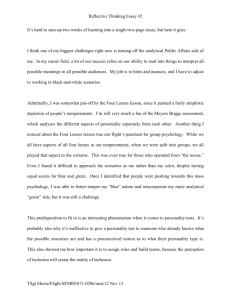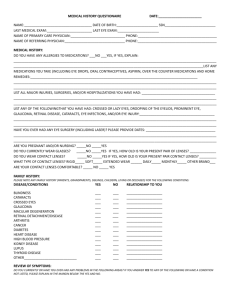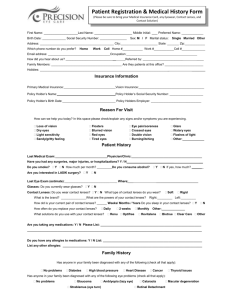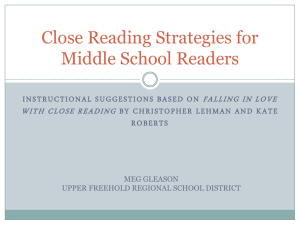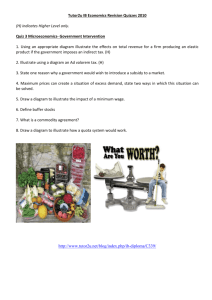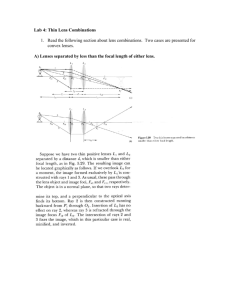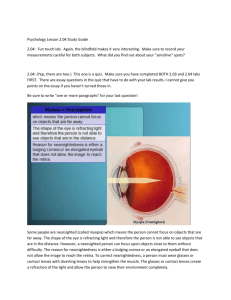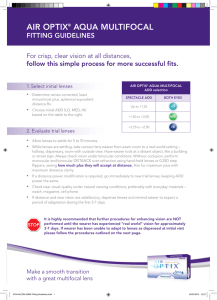Eye-InaBox - ShowMe InABox
advertisement
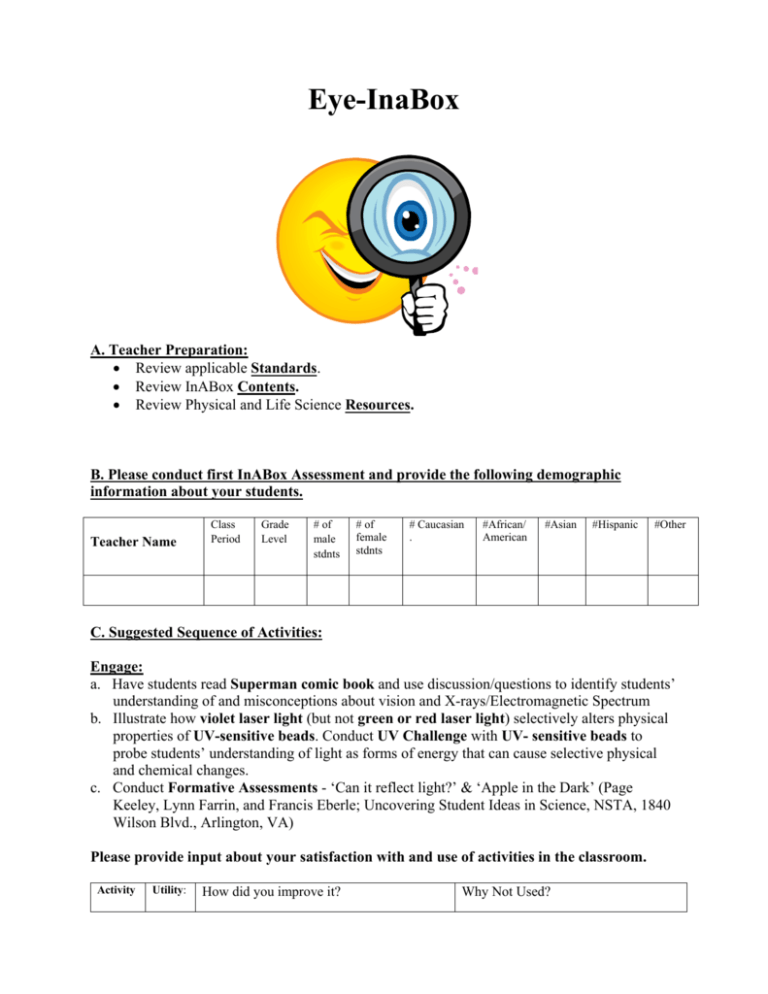
Eye-InaBox A. Teacher Preparation: Review applicable Standards. Review InABox Contents. Review Physical and Life Science Resources. B. Please conduct first InABox Assessment and provide the following demographic information about your students. Teacher Name Class Period Grade Level # of male stdnts # of female stdnts # Caucasian . #African/ American #Asian #Hispanic #Other C. Suggested Sequence of Activities: Engage: a. Have students read Superman comic book and use discussion/questions to identify students’ understanding of and misconceptions about vision and X-rays/Electromagnetic Spectrum b. Illustrate how violet laser light (but not green or red laser light) selectively alters physical properties of UV-sensitive beads. Conduct UV Challenge with UV- sensitive beads to probe students’ understanding of light as forms of energy that can cause selective physical and chemical changes. c. Conduct Formative Assessments - ‘Can it reflect light?’ & ‘Apple in the Dark’ (Page Keeley, Lynn Farrin, and Francis Eberle; Uncovering Student Ideas in Science, NSTA, 1840 Wilson Blvd., Arlington, VA) Please provide input about your satisfaction with and use of activities in the classroom. Activity Utility: How did you improve it? Why Not Used? High, Med, Low a b c Explore/Elaborate: a. Properties of visible light energy: a.1 Identify sources of visible light (sun, fluorescent and/or LED room lighting, computer screen, flashlight). Read with students, portions of “Physicists Change the Light Bulb” (http://www.sciencemag.org/content/346/6206/149.2.full) that illustrate how science and engineering are human activities which advance our lives. a.2 Have students measure and record light intensities of different sources with light meter. Determine how light intensity changes as a function of distance and the medium (air, liquid (water), solid (ice, plastic, glass) and absorptive properties through which light passes. a.3 Use Color Mixing Viewer to mix light of different energies/colors and Spin a Color Wheel to illustrate how our visual system and brain mixes colors. Discuss how visible white light is a mixture of different wavelengths/energies that our minds construct/perceive as white light. a.4 Refract sunlight with the prism to reveal multiple wavelengths/energies (perceived by our eyes as colors). a.5 Have students read DoubleVision (ReadWorks) and answer questions. Use polarized light filters to block light from sources such as computer screens. b. Readings for Science Literacy b.1 Have students read online journal article about color vision (http://kids.frontiersin.org/articles/10/how_do_we_see_color/) and discuss. See enclosed sheet - Possible Discussion Topics for How Do We See Color. c. Bending and focusing light waves c.1 Use Optics Simulation http://phet.colorado.edu/en/simulation/geometric-optics to describe how lenses can bend and focus light waves. Relate to magnifying glass and lenses of eyeglasses and contacts, so as to help focus an image upon the retina of an eye to improve vision. c.1.1 Ask students to change the curvature (thickness) of the lens. What thickness is required for light to focus perfectly on screen? What happens if the lens is too thick or too thin? Have students experiment with parameters so as to appreciate how light is bent and focused by lenses. c.2 Have students ‘grow’ lenses in water to investigate how images are formed. Explore with the students how the light beam of a laser pointer is bent as it enters and leaves the lens. (Gel “lenses” and individual student containers w/lids in box.) d. Conduct Formative Assessments (e.g.‘Birthday candles’) . (Page Keeley, Lynn Farrin, and Francis Eberle; Uncovering Student Ideas in Science, NSTA, 1840 Wilson Blvd., Arlington, VA) Please provide input about your satisfaction with and use of activities in the classroom. Activity Utility: High, Med, Low How did you improve it? Why Not Used a.1 a.2 a.3 a.4 a.5 b.1 c.1 c.1.1 c.2 d Explain: structure and function of the vertebrate eye. a. Examine (5x) anatomical model of human eye and describe its function. Have students complete terms and descriptions of these structural features on the diagram of eye. b. Use picture of retina and describe retina, optic nerve (blind spot) and vasculature. c. Have groups of students determine the diameter of the blind spot in their eyes. d. Have groups of students dissect cow eyes (cow eye dissection protocol) and http://www.exploratorium.edu/learning_studio/cow_eye/video_big_all.html) e. Have students read Handy Health Guide to Your Eyes (Silverstein and Nunn, Enslow Publishers, 40 Industrial Road, Berkeley Heights, NJ) and discuss. Please provide input about your satisfaction with and use of activities in the classroom. Activity Utility: High, Med, Low How did you improve it? Why Not Used a b c d e Extend: A. Assessment of human vision; vision impairment and its correction. a.1 Demonstrate use of ophthalmoscope with 5x anatomical model of eye. a.2 Have students measure each other’s vision using the vision chart. a.3 Have students read and discuss ‘Stevie Wonder’ (chapter 2) (Stevie Wonder: Musician (Black Americans of Achievement Series) [Jeremy K, Brown, Chelsea House Publishers, 132 West 31st Street, 17th Floor, New York, NY]); discuss his impairment of vision and how he has coped. a.4 Have students read and answer questions about Louis Braille (ReadWorks), and practice use of Braille cards and template and stylus with activity sheets. a.5 Have students find (in magazines, newspapers, online, etc) descriptions and advertisements about technological methods for improving eyesight, and discuss engineering means to overcome vision deficits, and how to test/optimize them. a.6 Discuss occupations, careers, education of vision healthcare professionals, neuroscientists, and optical engineers. (Scientists and Healers and Inventors, Wade Hudson, Just Us Books, Inc., 356 Glenwood Avenue, East Orange, NJ); African American Healers [Clinton Cox, John Wiley & Sons, Inc., 111 River St., Hoboken, NJ]; African American Scientists and Inventors [Otha Richard Sullivan, JosseyBass, One Montgomery St., Suite 1200, San Francisco, CA]; Optical Engineering and the Science of Light; [Anne Rooney, Crabtree Publishing, 350 Fifth Avenue, 59th Floor, New York NY]). a.7 Also see websites on health careers: www.mayo.edu/mshs/careers www.medicalcareerinfo.com B. Animal adaptations of vision b.1 Watch Animal Science – Extreme Vision http://www.youtube.com/watch?v=CR4ZYqRxTYk. b.2 Use Eye to Eye: How Animals See the World (Steve Jenkins, HoughtonMifflin Harcourt, 215 Park Avenue South, New York, NY) to illustrate the diversity of visual organs. b.3 Have students read and discuss online journal article about animal vision: http://kids.frontiersin.org/articles/02/the_truth_about_a_birds_eye_view/ b.4 Conduct formative (Complex Eye Assessment). Please provide input about your satisfaction with and use of activities in the classroom. Activity Utility: High, Med, Low How did you improve it? a.1 a.2 a.3 a.4 a.5 a.6 a.7 b.1 b.2 b.3 b.4 Evaluate: Conduct second InABox Assessment. Why Not Used

